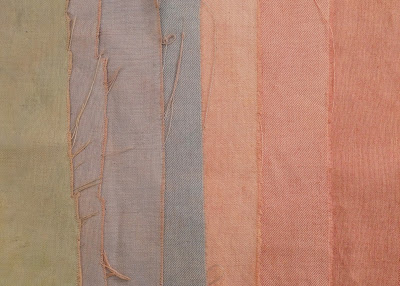 |
| - The results: cotton dyed with madder with overdyeing of other natural colours. |
After growing woad (Isatis tinctoria) and dyeing cotton to create a spectrum of blues (- click here- ), I attempted to grow madder (Rubia tinctorum) in order to create a red dye.
The root of madder produces a red dye that has been used throughout history from Tutankhamen's tomb [1] to the Vermeer's paintings [2]. The wild relative of the cultivated madder is known from Europe and the Near East, and is though to have been cultivated in Egypt potentially as far back as 14000 BC [3,4]. From it's cultivation the derived red colours of madder have been described by Herodotus in ca. 450 BC, Hippocates in ca. 400 BC and Pliny the Elder in ca. 77-79 AD among many [3].
For a fascinating study of the botanical and cultural roots of madder - click here-.
I purchased an older madder plant from Woolfest, the original British Wool Festival that is held annually nearby at Cockermouth. I then cared for the plant for around 3 years- it stayed outside during the summer months and was placed in a greenhouse during the winter. Despite my best attempts at caring for it it never really thrived and any attempts at splitting the root mass failed. As a result, this autumn I decided to dig up and process it. There are many different 'recipes' for dyeing with madder online so I won't go into it here but this is a summary of my process:
- Dig up the root and wash it, discarding small thread-like roots but retaining the majority of woody roots.
- Pick through the roots, cutting it into small sections and cleaning where necessary.
- Dry the roots
- Cut and grind the roots into small chips to powder (I did this in a small spice grinder).
- Soak in cold water for 30 minutes and place pre-soaked, pre-mordented (with alum) cotton into the dye pot.
 |
| The dye pot. |
- Add a small amount of crushed chalk.
- Bring up to around 80-90oC without boiling the dye pot for around 20 minutes.
- Rinse and wash off madder fragments.
I probably could have left the cotton in the dye pot for a greater period of time in order to achieve a deeper red colour, in fact most of the processes could have been done for longer- patience is key!
 |
| Prior dyeing- woad (blues) and woad overdyed with dyer's greenweed (greens). |
 |
| The results: left: khaki green (overdyed green), purple-blue (overdyed blue) and reds (madder). |
In the future I would like to grow more madder. I was heavily restricted by little dye material so I'd like to grow a few plants over a few years to get some more roots to allow me to experiment a bit more.
[1] Crowfoot GM, Davies N. 1941. The tunic of Tutankhamun. The Journal of Egyptian Archaeology. 27:113-130.
[2] Jansen J. 2017. Vermeer's Palette. Accessed from: http://www.essentialvermeer.com/palette/palette_vermeer'_palette.html#.WeprRGhSzmY on the 28/09/21.
[3] LaBerge M. 2018. The Heart of the Madder: An Important Prehistoric Pigment and Its Botanical and Cultural Roots. MSc. Thesis. Univeristy of Wisconsin: Milwaukee. [4] Eastwood G. 1984. Egyptian dye and colours. Dyes on Historical and Archaeological Textiles. York Archaeological Trust, National Museum of Antiquities: Edinburgh.

Comments
Post a Comment